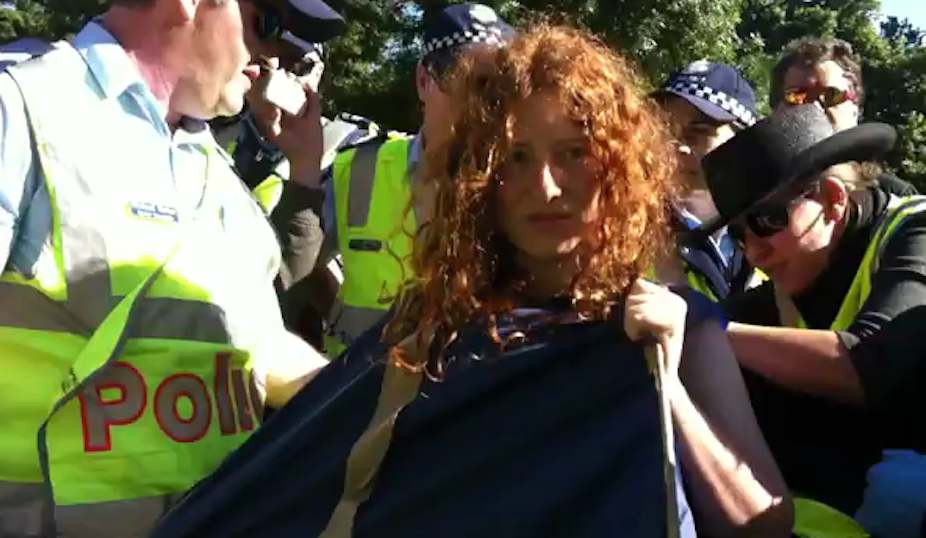When police removed a young woman’s “tent dress” this week at the Occupy Melbourne encampment, it was yet another controversial interaction between protesters and authorities.
As shown in the Occupy movement, the increasing regulation of public spaces through intensive policing is a global phenomenon. Governments across Australia are introducing increasingly strident laws to police public spaces.
However, the evidence shows that these powers do not reduce crimes, they are exercised in a discriminatory way against young people, racial minorities and people experiencing homelessness, and they breach the norms and standards of international human rights laws.
Legal confusion
Occupy Melbourne demonstrators were first evicted by police from City Square in October. Afterwards, there were conflicting explanations about the legal basis for protesters’ removal. It seemed that government, police and the local council were all citing different laws.
The Police Minister’s office suggested police were using the move-on powers contained in section 6 of the Summary Offences Act. But these powers were created in 2009 to help police deal with alcohol-fuelled violence; they specifically prevent police from moving on people “demonstrating or protesting”.
Vulnerable targets
Move-on powers allow police to control both the users and the usage of public space. Similar laws have been introduced in most Australian jurisdictions, with troubling implications.
Legal expert, Ben Saul notes that “particularly if you are a young person, indigenous, homeless, or a sex worker, police scrutiny and state surveillance of the public use of public streets has become acute”. Empirical research is limited and not very recent, but it does point to discriminatory use of move-on powers.
People experiencing homelessness - like Bruce Rowe, who was brutally arrested by Queensland police in 2006 - occupy public spaces out of necessity but are disproportionately and adversely affected by move-on powers.
A Brisbane survey of 132 people experiencing homelessness found a total of 76.5% of respondents had been told to move on one or more times in the last six months. Nearly 78% of respondents who received a move-on direction said their behaviour was innocuous and unlikely to meet the threshold requirements for a lawfully issued move-on direction.
Concerns about police “chasing” homeless people from one place to the next were raised throughout this research. Some respondents stated that it was often the same officers that followed homeless people throughout the day to “chase them away”. I often heard stories like this when I worked as a lawyer with Victoria’s Homeless Persons’ Legal Clinic.
Unequal treatment

Indigenous Australians appear most likely to be moved on compared to other community members. A detailed 1995 study found that Indigenous young people were over-represented at every level of the justice system except police cautions.
This certainly appears to be the case with move-on orders. Chan and Cunneen note that police use “move-on” powers against Aboriginal people at a massively disproportionate rate.
The New South Wales Ombudsman expressed concern with the large numbers of Aboriginal and Torres Strait Islander people given direction to move on. This brings otherwise law-abiding individuals into contact with the criminal justice system in areas where relationships between the police and Aboriginal communities have been very poor.
Young not welcome
But it’s not only Indigenous young people who are over-policed by these move-on powers. The struggle over territory between police and young people is not a new phenomenon.
A 1992 study found that 80% of young people aged 15 to 18 had been stopped by the police, and that 83% of them had been stopped on the street. In addition, 53% of the police officers who participated in the research thought that young people were causing problems in malls.
The disparity between young people being moved on by police, and the rate of their involvement in crime compared to their representation in the population, is disturbing. The disparity suggests police are not using the powers as an effective tool and are exercising the power in a discriminatory fashion.
This does not reduce the incidence of crime and it may lead to even more unsatisfactory outcomes. Police and young people may come into conflict or young people may be pushed into more serious offending behaviours.
There is no evidence, in Australia or internationally, that suggests move-on powers reduce crime rates.
Breaching human rights?
Human rights lawyers have suggested that the October eviction of Occupy protestors may breach Victoria’s Charter of Human Rights and Responsibilities Act.
Researchers have previously questioned the human rights implications of move-on powers and other regulation of public space. The exercise of these police powers engages Charter rights including freedoms of movement, association and expression, among others.
Infringement of these rights, particularly given the disproportionate impact on vulnerable groups discussed above, may amount to an unreasonable limitation of the rights. This question is currently before the Courts, following action brought by an Occupy Melbourne protester.
As the Occupy movement challenges some of the existing power structures, let’s hope that this draconian legal development of police move-on powers is one of the first casualties.

